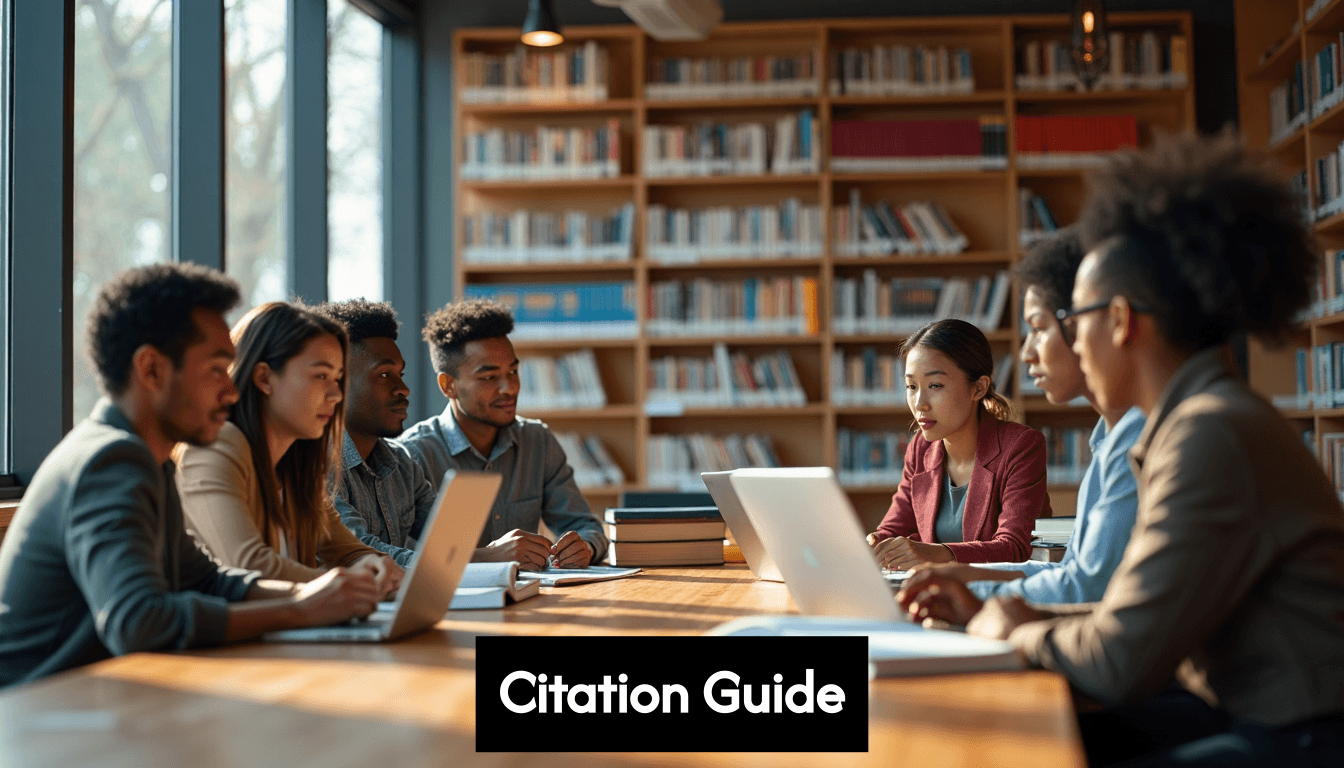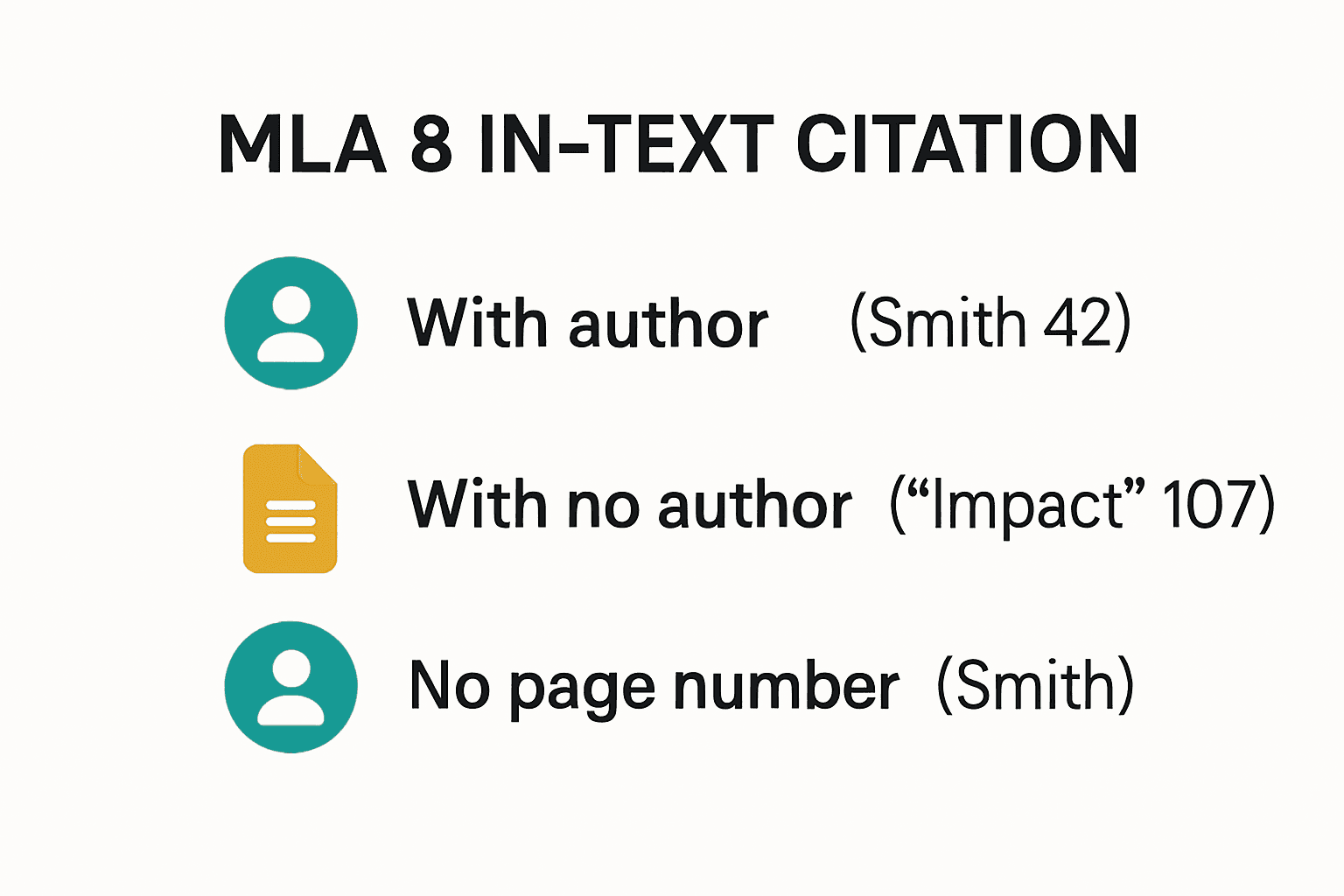Blog
Learning Materials
MLA 8 In Text Citation Guide for 2025: Clear Examples
Updated: June 21, 2025

MLA 8 in-text citation rules have changed the way students and researchers handle source attribution. More than 60 percent of academic papers now reference digital sources instead of traditional print. That might make citation sound easier than ever. Yet many miss a critical detail. The real challenge is applying MLA’s flexible guidelines when there are no page numbers or authors at all. This guide uncovers clear solutions and examples for every situation so you can stop second guessing and start citing with total confidence.
Table of Contents
Quick Summary
| Takeaway | Explanation |
|---|---|
| Core Principles of MLA 8 | In-text citations require the author's last name and page number in parentheses, with flexibility for sources without page numbers, emphasizing clarity and consistency across various types of sources. |
| Citing Different Source Types | MLA 8 accommodates diverse sources, allowing for proper citation without page numbers by using the author's name or a shortened title when necessary, ensuring stable attribution across print and digital mediums. |
| Common Mistakes to Avoid | Researchers often err in citation formatting and source completeness; ensuring proper placement, punctuation, and ensuring each citation corresponds to an entry in the Works Cited list upholds academic integrity. |
| Utilizing Technology | Leveraging citation management tools and digital resources can streamline the citation process, making it more efficient and reducing errors, which is especially helpful for students and educators in mastering MLA 8. |
Understanding MLA 8 In Text Citation Rules
MLA 8 in-text citations create a critical bridge between your research and the original sources, providing readers with clear attribution and credibility. These citations serve as precise roadmaps that guide readers directly to the full reference in your Works Cited list.
Core Principles of MLA 8 In-Text Citations
The fundamental goal of MLA 8 in-text citations is simplicity and clarity. Unlike previous versions, MLA 8 emphasizes a universal set of guidelines that work across various source types. According to Penn State University Libraries, the basic format requires the author's last name and page number in parentheses immediately following the referenced material.
For print sources and digital texts with page numbers, the citation follows a straightforward pattern. If you quote or paraphrase from a source, you'll include the author's last name and the specific page number. For example: "Climate change impacts are accelerating global environmental transformations" (Smith 163). When the author's name is mentioned in the sentence, only the page number appears in parentheses.

Handling Different Source Types
MLA 8 recognizes the complexity of modern research sources. For sources without page numbers such as websites or digital materials, you'll typically include just the author's last name in parentheses. When no author is identifiable, use a shortened version of the source title. Our comprehensive MLA citation guide provides detailed examples for these scenarios.
Some key variations in MLA 8 in-text citations include:
- Multiple Authors: For sources with two authors, include both last names. For three or more authors, use the first author's last name followed by "et al."
- No Author: Use a shortened title in quotation marks
- Multiple Works by Same Author: Include a brief title to differentiate sources
Researchers must remember that every in-text citation must correspond precisely to an entry in the Works Cited list. This connection ensures that readers can easily trace and verify the original source of your information. Accurate and consistent citation is not just an academic requirement but a fundamental aspect of scholarly integrity.
The beauty of MLA 8 lies in its adaptability. Whether you're citing a tweet, a scholarly journal, or a book chapter, the core principles remain consistent. This standardization makes research more accessible and transparent across different disciplines and publication platforms.
How to Cite Different Source Types in MLA 8
MLA 8 provides a flexible framework for citing an increasingly diverse range of sources, adapting to the complex landscape of modern research and digital content. The standardized approach ensures consistent attribution across print, digital, and multimedia sources.
Print and Traditional Sources
Traditional print sources like books and academic journals follow the most straightforward citation method. According to Purdue Online Writing Lab, book citations require the author's last name and page number. For instance: "The economic transformation revealed complex systemic changes" (Johnson 45). When the author is named in the text, only the page number appears in parentheses.
Digital and Emerging Media Sources

Digital sources present unique citation challenges that MLA 8 addresses with remarkable flexibility. Our comprehensive MLA citation guide highlights that sources without page numbers typically use the author's last name. For websites, online articles, and social media posts, this means citing by the creator's name or username.
Unique digital source citation examples include:
- Websites: (Smith)
- Social Media Posts: (Jones)
- YouTube Videos: Include time stamp for specific references, such as (Garcia 00:03:25)
- Podcasts: Cite episode or time stamp as needed
For sources with no clear author, use a shortened version of the title in quotation marks. Academic databases and online platforms often require creative adaptation of these principles.
The MLA 8 approach recognizes that modern research spans beyond traditional print media. Researchers might cite tweets, blog posts, streaming content, and other digital materials using consistent core principles. The universal method ensures clarity regardless of the source's origin.
Key considerations for digital source citations include identifying the most appropriate container (website, platform, database) and using the most relevant identifying information. When page numbers are unavailable, researchers should prioritize other unique identifiers that help readers locate the original source.
Researchers must always remember that precision matters. Each citation should provide enough information for readers to easily find the original source in the Works Cited list. This approach maintains academic integrity while accommodating the rapidly evolving landscape of information and media.
Common Mistakes and How to Avoid Them
MLA 8 in-text citations might seem straightforward, but many researchers encounter subtle pitfalls that can compromise the accuracy and professionalism of their academic writing. Understanding these common mistakes is crucial for maintaining scholarly integrity.
Incorrect Citation Formatting
One of the most frequent errors in MLA 8 citations is improper formatting. According to Penn State University Libraries, researchers often struggle with consistent placement and punctuation of in-text citations. The citation should appear immediately after the quoted or paraphrased material, with punctuation carefully positioned.
Common formatting mistakes include:
- Misplaced Parentheses: Placing citations in incorrect locations within sentences
- Incorrect Punctuation: Putting periods or commas outside the parenthetical citation
- Inconsistent Author Name Usage: Switching between full names and last names
Incomplete or Missing Source Information
Another critical mistake is failing to provide comprehensive source information. Our comprehensive citation guide emphasizes that every in-text citation must correspond precisely to an entry in the Works Cited list. Researchers frequently overlook this crucial connection, potentially rendering their citations incomplete or untraceable.
To avoid this issue, always ensure:
- Every cited source has a full Works Cited entry
- Digital sources include stable URLs or DOIs
- Complex sources like multimedia or web content have complete identifying information
Additionally, researchers must be meticulous about identifying the most appropriate author or creator for digital sources. Social media posts, collaborative websites, and emerging media platforms often require creative approaches to attribution.
Some advanced strategies for avoiding citation mistakes include:
- Double-checking each citation against the original source
- Using citation management tools
- Consulting the latest MLA Handbook for updated guidelines
- Seeking feedback from academic advisors or writing centers
Particularly challenging are sources without clear authorship or page numbers. In these instances, researchers must use alternative identifiers like section headings, paragraph numbers, or timestamps to help readers locate the referenced material.
Understanding these nuanced challenges demonstrates the complexity of academic writing. While MLA 8 aims to simplify citation processes, it still requires careful attention to detail. Researchers who master these subtleties will produce more credible and professionally formatted academic work.
Remember that citation is more than a technical requirement. It represents scholarly respect, allowing readers to trace ideas, verify sources, and engage with the broader academic conversation. Precision in citation reflects the rigor and integrity of academic research.
Helpful Tips for Students and Educators
Mastering MLA 8 in-text citations requires strategic approaches that go beyond simple memorization. Students and educators can transform citation from a tedious task into a refined academic skill with the right techniques and understanding.
Developing a Systematic Approach
Successful citation begins with establishing a consistent workflow. According to Purdue Online Writing Lab, developing a systematic method for tracking sources is crucial. This means creating a research journal or digital system where you immediately record source details when first encountering them.
Effective strategies include:
- Source Tracking: Maintain a running document with full bibliographic information
- Digital Bookmarking: Use citation management tools to automatically capture source details
- Immediate Documentation: Record source information the moment you find a useful reference
Practical Technology and Resource Integration
Our comprehensive citation guide emphasizes the importance of leveraging modern tools to streamline the citation process. Technology can significantly reduce the complexity of MLA 8 citations, making the process more efficient and accurate.
Recommended technological approaches include:
- Citation Management Software: Tools like Zotero or EndNote that automatically format citations
- University Library Resources: Online guides and citation workshops
- Digital Reference Checkers: Automated tools that verify citation accuracy
Educators should encourage students to view citations not as a bureaucratic requirement but as an essential academic communication tool. Each citation represents a connection to broader scholarly conversations, demonstrating intellectual rigor and respect for original research.
For students, developing citation skills early transforms an intimidating process into a natural academic habit. Practice and consistent application are key. Start by carefully documenting sources during initial research stages, rather than attempting to reconstruct citations after completing a draft.
Advanced learners should focus on understanding the underlying principles of MLA 8 citation, not just memorizing rules. This means comprehending why certain information is important and how citations facilitate academic dialogue.
Critical considerations for both students and educators include:
- Recognizing citations as intellectual bridges
- Understanding the ethical implications of proper source attribution
- Viewing citations as part of the research storytelling process
Ultimately, MLA 8 in-text citations are about clear communication. They allow readers to trace your intellectual journey, verify your sources, and engage more deeply with your research. By approaching citations as a collaborative academic practice rather than a restrictive set of rules, students and educators can transform this skill from a requirement into an art form.
Frequently Asked Questions
What is an MLA 8 in-text citation?
An MLA 8 in-text citation is a brief reference within your text that indicates the source of information, typically comprising the author's last name and the page number, allowing readers to locate the full citation in the Works Cited list.
How do I cite a source without page numbers in MLA 8?
For sources without page numbers, such as websites, include only the author's last name in parentheses. If no author is available, use a shortened version of the source title in quotation marks.
What are common mistakes to avoid in MLA 8 citations?
Common mistakes include incorrect formatting, such as misplaced parentheses and improper punctuation, and failing to provide complete source information that corresponds to entries in the Works Cited list.
How can technology help with MLA 8 citations?
Utilizing citation management tools like Zotero or EndNote can streamline the citation process, making it more efficient and ensuring accuracy in formatting according to MLA 8 guidelines.
Take the Guesswork Out of MLA 8 Citations—Let Samwell.ai Boost Your Confidence
Perfect MLA 8 in-text citations can feel like a maze, especially with so many digital sources and unclear rules. If you're tired of second guessing every citation, worrying about formatting mistakes, or stressing over missing details for online articles, why not let smart technology solve these challenges for you? Samwell.ai is designed with your academic needs in mind, giving you tools that generate accurate citations and keep your papers credible, no matter how flexible MLA guidelines get.

Join over a million students and professors already using Samwell.ai to eliminate citation stress and produce papers with flawless MLA 8 compliance. With real-time editing support, plagiarism checks, and built-in citation management, you can focus on writing—not on tedious details. Try Samwell.ai’s advanced writing tools today and see how easily your next paper can meet every citation standard. Start now to make every reference count and build your academic confidence.
Recommended Articles
Generate essays with Samwell.ai
Whether you’re a publisher, professor, journalist, or student, let us tailor a plan just for you.Most Read Articles

Your Guide to Help Writing a Essay Successfully
Expert tips for help writing a essay - from crafting a thesis to structuring your essay effectively.

How to Write Critical Thinking Essay: Expert Tips
Expert tips for writing a critical thinking essay. Learn how to structure, choose topics, and use evidence effectively.'

How to Write a Good Hook: A Step-by-Step Guide
Master the art of crafting a good hook with our guide. Create compelling openers for a memorable first impression.
